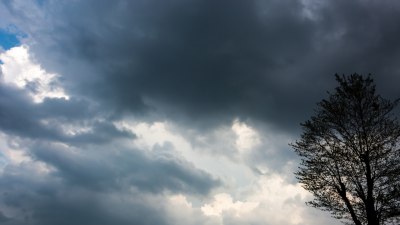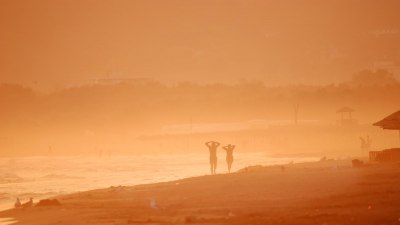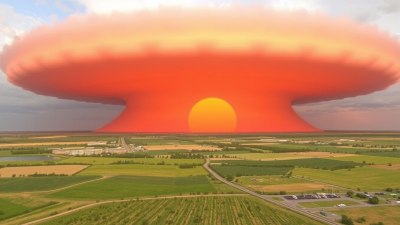How a Heatwave Stirs Up Things We Thought Were Settled
Explore the surprising ways heatwaves disrupt environments, societies, and systems once considered stable or resolved.

Heatwaves have always been a dramatic feature of our planet's climate, but recent occurrences reveal that these seemingly temporary spikes in temperature do more than just raise the thermostat. They shake up ecological balances, social systems, and even long-standing assumptions about climatic stability. When the air thins with heat and the sun blazes without relief, the chain reactions set off ripple through far more than just weather charts.
Most people think of heatwaves simply as uncomfortable or dangerous stretches of hot weather—periods when temperatures soar above normal for days or weeks, leading to increased risks of heatstroke and wildfires. While this is true, the true power of a heatwave comes from its ability to serve as a stress test for natural systems and human infrastructure, revealing weaknesses and challenges that had previously gone unnoticed or ignored.
Ecological Disruptions Beyond the Obvious
Heatwaves can bluntly upend ecological equilibriums. One well-studied effect is the sudden die-off of aquatic animals, where water temperatures exceed the tolerance limits of fish and amphibians. When water heats beyond certain thresholds, oxygen levels decrease, putting enormous pressure on aquatic life. This not only causes immediate mortality but also disrupts breeding cycles and food chains, often leading to longer-term population declines.
But the impact is not confined to aquatic ecosystems. Terrestrial plants also suffer during extreme heat. Drought conditions often accompany heatwaves, leading to soil desiccation and reduced nutrient absorption. Trees experience increased stress which can reduce growth rates or make them susceptible to pests and diseases previously kept under control. The loss or weakening of tree populations affects carbon sequestration, shading patterns, and habitat availability, cascading through the ecosystem.
Heatwaves also alter the behavior of pollinators, insects, and birds. Elevated temperatures can shift flowering times and food availability, causing mismatches between species that depend on each other. This disruption can reduce crop yields and the viability of native plant populations, shaking the foundations of food webs. In agricultural regions, heatwaves spell trouble for both wild biodiversity and food security, challenging the notion that seasons and growth cycles are stable and predictable.
Urban Heat Islands and Societal Stress
In cities, heatwaves collide with the urban heat island effect, where concrete and asphalt absorb and re-radiate heat more than natural landscapes. This phenomenon can push urban temperatures several degrees higher than surrounding rural areas, intensifying health risks for residents. Vulnerable populations, including the elderly and those with preexisting health conditions, face heightened levels of heat-related illnesses like heat exhaustion and heatstroke.
Moreover, during heatwaves, energy consumption spikes as residents rely more heavily on air conditioning. This surge strains electrical grids, sometimes leading to blackouts that exacerbate health risks during critical periods. The reliability of infrastructure once taken for granted is thus called into question, exposing weaknesses in urban planning and preparedness strategies.
Economic and Agricultural Shocks
Heatwaves impose significant economic costs, often underestimated or realized too late. Crop failures due to heat stress, combined with drought, translate into decreased yields and increased prices for consumers. Farmers may lose entire harvests, which affects their livelihoods and disrupts supply chains.
Livestock also suffer during heatwaves, as animals struggle to regulate body temperature and face dehydration or heat exhaustion. Productivity decreases, and mortality rates can rise, creating a ripple effect in the food industry.
Industries dependent on water, such as manufacturing and power generation, face challenges during heatwaves. Cooling systems can become less efficient or break down, leading to reduced output or shutdowns. The increased energy demand coupled with physical strain on machinery underscores vulnerabilities in industrial operations amid climate stress.
Public Health and Psychological Impacts
Beyond immediate physical health risks, heatwaves contribute to longer-term psychological effects. Prolonged exposure to oppressive heat can lead to irritability, aggression, and increased mental health complaints. Disrupted sleep patterns worsen cognition and emotional resilience, leading to reduced productivity and social tensions.
Heatwaves also highlight and exacerbate socioeconomic inequalities. Those without access to adequate cooling, sufficient hydration, or medical care suffer disproportionately. Homeless populations, communities in dilapidated housing, and workers in outdoor labor sectors are particularly vulnerable. This social dimension reveals how environmental events challenge assumptions about equitable societal stability.
Challenges to Water Resources and Management
Water scarcity often accompanies heatwaves, especially when drought conditions ensue. Reservoirs and groundwater supplies dwindle due to higher evaporation rates and increased demand for irrigation and personal use. Municipal water systems may impose restrictions to conserve supplies, which can affect daily life and public hygiene.
The strain on water resources can lead to conflicts at regional levels, especially where water rights are contentious. Agriculture, industry, and residential use must compete for limited supplies, forcing difficult policy decisions. This competition disrupts previously stable water-sharing agreements and tests governance frameworks.
Atmospheric Feedback Loops and Climate Implications
Heatwaves themselves may be amplified by atmospheric feedback loops. For instance, prolonged dry conditions reduce soil moisture, which in turn diminishes evaporative cooling that would normally moderate temperatures. This can create conditions for even more extreme heat spikes, forming a vicious cycle.
Urban areas often contribute to these feedbacks through surface modifications and pollution. Additionally, heatwaves can increase the frequency and intensity of wildfires, releasing stored carbon into the atmosphere and feeding climate change further.
The disruption of previously stable climatic patterns by heatwaves challenges meteorological assumptions and complicates forecasting. This unpredictability makes it harder for communities and governments to prepare and respond effectively.
Technological and Infrastructure Vulnerabilities Exposed
Heatwaves reveal weaknesses in modern infrastructure that society often takes for granted. Roads buckle, rail lines deform, and bridges expand beyond design tolerances under intense heat. This leads to transportation delays and safety hazards, potentially affecting commerce and emergency response capabilities.
Coolant systems in data centers and other critical facilities may be overwhelmed, risking data loss and operational interruptions. Communication networks can falter due to equipment overheating, hampering disaster management and public information flow precisely when it is most needed.
Legal and Policy Dimensions
Extreme heat events prompt reexaminations of existing laws and policies regarding building codes, labor protections, and environmental standards. Heat safety regulations for outdoor workers often fall short during unprecedented heatwave events, spurring calls for stronger protections and enforcement.
Urban planning policies may need revision to enhance heat resilience, including greater green space, reflective building materials, and innovative cooling technologies. Water management policies must balance conservation with equitable access under increased stress conditions.
Insurance frameworks are also put to the test, as claims spike from heat-related damages. This challenges the sustainability of current models and demands new approaches to risk assessment and disaster preparedness.
A Cultural Shift in Climate Awareness
Heatwaves serve as visceral reminders that climate dynamics are fluid and can rapidly disturb status quos. These events foster increased public and political urgency around climate adaptation and mitigation efforts. Communities may adopt new behaviors, technologies, and policies aimed at reducing vulnerability and enhancing resilience.
At the same time, heatwaves expose disparities in who suffers and who is protected, pushing climate justice to the forefront of discourse. This refocuses debates on equitable resource distribution and inclusive decision-making.
Innovations Spurred by Thermal Extremes
The urgency created by heatwaves drives innovation across sectors. Advances include heat-resistant crop varieties, new architectural designs emphasizing natural ventilation, and urban greening projects that reduce local temperatures. Energy systems are pivoting towards more flexible and renewable sources that can better absorb variable demand.
Technology to monitor heat stress in populations, automated irrigation systems that optimize water use, and wearable devices that track body temperatures are helping individuals manage heat risk more effectively. These innovations transform challenges into opportunities for sustainable progress.
In sum, heatwaves unsettle a wide array of natural and human systems once thought stable. They reveal vulnerability, encourage innovation, and reshape relationships with the environment. Rather than viewing these events as anomalies, recognizing their role as catalysts provides a clearer path forward for resilience in a warming world.











